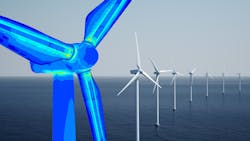Overcoming offshore wind industry obstacles with digital twins
Editor's note: This story first appeared in the 2023 Offshore Wind Special Report, which published within the September/October 2023 issue of Offshore magazine.
By Guillaume Lechaton, Akselos
The journey to net-zero emissions, critical for mitigating the impacts of climate change, has cast the global spotlight on the potential of offshore wind power. In particular, institutions such as the International Renewable Energy Agency (IRENA) have underscored the sector's pivotal role in this energy system transformation. IRENA has set ambitious goals that require at least 2,000 GW of offshore wind power to be deployed by 2050 to maintain the pathway to limiting global warming to 1.5 C and delivering net-zero emissions by mid-century. However, this path forward is not without significant obstacles.
One of the most substantial hurdles facing the sector and stalling growth is the escalating capital expenditure costs. A complex confluence of factors, including global inflation, an ongoing pandemic and geopolitical conflict in Europe, has driven up the costs of essential raw materials.
These essential minerals form the backbone of the wind industry's manufacturing processes, from copper, zinc and manganese to chromium, nickel, molybdenum and rare earth elements. Yet, their costs have surged drastically between January 2020 and March 2023, from a 23% increase for zinc to a staggering 285% for molybdenum. This price inflation has led to a corresponding rise in wind turbine costs, which have risen by 38% over the last two years.
Rising costs: Stumbling block for OEMs
The ripple effects of these rising costs are being acutely felt by original equipment manufacturers (OEMs), which are losing billions. Vestas, a leading onshore turbine supplier, posted a net loss of 1 billion euros ($1 billion) in the first nine months of 2022. Similarly, Siemens Gamesa ended the 2021 fiscal year with a net loss of 940 million euros ($1 billion). In the first half of 2022, Nordex, Europe's third largest supplier, reported a net loss of 283 million euros ($302.7 million). In an attempt to offset these losses and guard against cost inflation pressures, Vestas raised the selling price of its wind turbines by more than 20%, reaching the highest price in the last decade, as revealed by CEO Henrik Andersen in August.
The road to achieving net-zero emissions will eventually require the construction of larger, more powerful turbines that can generate an increased amount of electricity. However, with costs spiraling, the industry must find a solution that doesn't exacerbate this financial burden. The key lies in optimizing turbine designs to create lighter structures requiring less expensive raw materials.
Floating offshore wind represents a significant opportunity in this regard. Traditional design practices in this sector have often led to conservative and, therefore, heavier and costlier structures. However, utilizing existing resources more efficiently with more considered innovation is now critical to unlock the sector's vast potential.
Digital twins
This is where the transformative potential of digital twin technology comes into play. This technology is enabling rapid concept screening and comprehensive design comparisons at a previously unattainable precision level. By allowing engineers and designers to simulate and test various configurations and scenarios, digital twin technology has opened the door to design optimizations that were once considered impossible.
One example is the DigiFloat project, a collaboration between Akselos and Principle Power. This initiative created the world's first digital twin tailored specifically to floating offshore wind applications. The project has significantly enhanced design capabilities by enabling a detailed, digital replica of a floating wind turbine to be manipulated and tested under various conditions, allowing for leaner, more cost-effective structures.
As the DigiFloat project illustrates, digital twin technology can reduce costs by enabling more efficient designs that require fewer resources. This has the potential to alleviate the financial burden currently experienced by OEMs and act as a catalyst for the sector's growth, accelerating progress toward the ambitious 2050 targets set by IRENA.
Hope for a greener future
Despite significant challenges, including rising capex costs, the offshore wind industry has promising solutions on the horizon. Digital twin technology, as illustrated by the pioneering DigiFloat project, is set to revolutionize turbine designs, reducing costs and resource use. Such innovative advancements offer hope for a more sustainable and resilient industry, providing a crucial pathway to ambitious climate goals. Right now the industry is sailing against the wind, but the promise of a greener, cleaner future, powered significantly by wind, is within reach.
